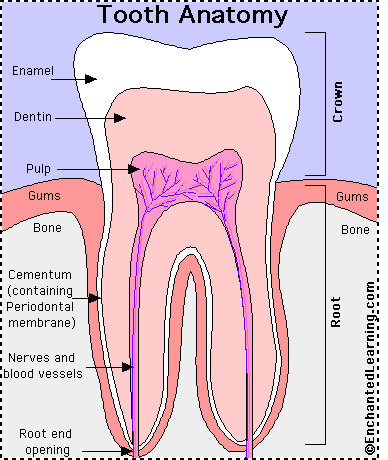Dental and Oral Anatomy
Crown:
the portion of the tooth that is visible above the gumline
Root:
the portion of the tooth that is not normally visible and is below the gumline
Enamel:
the outer covering of the tooth crown
Teeth are one of the body’s
hardest naturally occurring substances. They are strong enough to adequately
resist normal wearing that occurs over a lifetime of chewing food. Teeth are
composed of several different parts¾enamel, dentin, cementum,
and pulp (nerve) tissue. The enamel is the outside covering of the tooth. It is
the part of the tooth that you normally see when a person smiles. Yet, while
enamel is very hard, it is also very brittle. It is mostly inorganic in nature.
When fluoride is incorporated into the enamel (systemically when the enamel is
forming, topically when the tooth is in the mouth), it becomes more resistant
to acid attack and decay. The enamel of the tooth covers the inner layers of
the crown portion of the tooth.
Dentin: the layer beneath
the enamel
Dentin is not normally
visible. Only when a tooth breaks or is worn can it be noticed. Dentin is
darker in color, softer, and more resilient than enamel. Small nerve fibers
running from the dentin to the pulp can make the tooth sensitive to temperature
changes or other stimuli when dentin is exposed to the oral cavity. If a tooth
is sensitive, many times, exposed dentin is the reason. Dentin, when exposed to
the oral cavity, will wear away faster than enamel, and this can lead to other
dental problems.
Pulp: the innermost tooth
layer
The pulp of the tooth is
composed of soft, highly organic material¾mostly nerve fibers and
blood vessels. When the pulp becomes damaged from deep decay or other dental
problems, it can become abscessed and must then be treated with endodontic
therapy (root canal) or be extracted.
Cementum: the outer covering
of the root of the tooth
The root of a tooth is
normally not seen. It is surrounded and covered by bone and gum tissue. The
root is covered by a thin layer of cementum. Cementum is similar to dentin in
composition and can decay or wear away if exposed in the mouth. Fibers that
attach the tooth to the bone are embedded in the root cementum and serve as
shock absorbers during normal functioning, such as chewing.
Bone: the structure that
makes up the jaws
The bone that surrounds each
tooth is less dense in the upper jaw and more dense in the lower jaw. As with
bone elsewhere in the body, it can undergo resorption and repair. The spaces in
which the teeth rest, called sockets,
provide the pathways for a rich supply of blood and nutrients and other vital
fluids to reach the teeth.
If you have any questions about dental and oral anatomy, please feel
free to ask us at (512)250-5012.
-Omni Dental Group


Teeth's are strong enough to adequately resist normal wearing that occurs over a lifetime of chewing food. Nice way to describe the dental structure of an individual's, so he can take proper precautions of dental issues. Pickering Dentist provides you advise on how to prevent your teeth from dental problems.
ReplyDeletePeople should know the oral anatomy perfectly. it is highly important. Dental health is one of the most important matter to be concerned. costa rica dental tourism can provide us great tips and services regarding dental treatment.
ReplyDeleteYour thinking toward the respective issue is awesome also the idea behind the blog is very interesting which would bring a new evolution in respective field. Thanks for sharing.
ReplyDeleteBest Dental Clinic In Annanagar
Best Dental Clinic In Velachery
wow really superb you had posted one nice information through this. Definitely it will be useful for many people. So please keep update like this.
ReplyDeleteBest Dental Clinic in Alwarpet
All on 4 Dental Treatment
Sedation Dentistry in Chennai
Laser Root Canal Treatment In Chennai
Nice post. Dental treatment is sometime expensive and you may need a lot of money to continue the entire treatment that usually not afforded by your dental insurance. In this aspect stand alone dental discount plans in Tennessee can help.
ReplyDelete